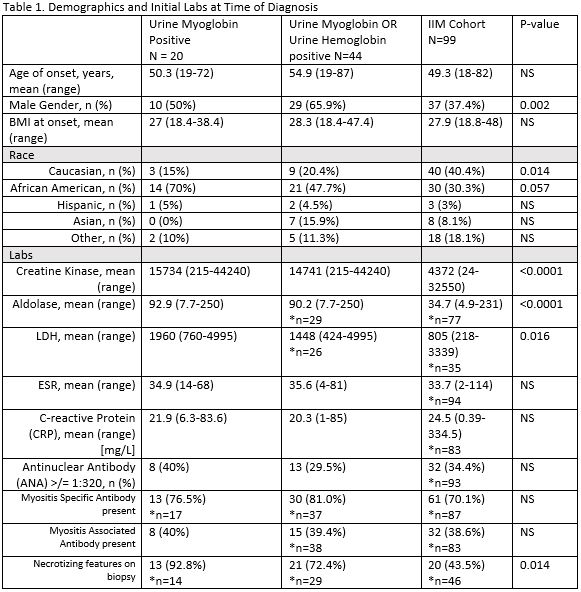Session Information
Session Type: Poster Session B
Session Time: 8:30AM-10:30AM
Background/Purpose: The Idiopathic Inflammatory myopathies (IIM) are characterized by muscle damage and progressive weakness. Myoglobin is not typically released in high levels in IIM and myoglobinuria is more typically found in rhabdomyolysis. Myoglobinuria has been rarely described in inflammatory myositis. This study aims to describe the frequency, significance, and associated clinical characteristics of myoglobinuria in IIM patients receiving care through the military healthcare system.
Methods: We performed a retrospective chart review of patients diagnosed with an inflammatory myositis within the Department of Defense (DoD) between January 2006 and December 2020. Patients were identified by ICD-10 diagnosis codes for inflammatory myositis and included if diagnosed at one of fifteen medical facilities within the DoD. All patients met either the Bohan and Peter 1975 or EULAR/ACR classification criteria for definite or probable myositis. Demographic and laboratory data were identified at initial presentation. Myositis complications and treatment regimens were collected during the follow up period. Clinical outcomes were based on the most recent documentation by the evaluating physician. We identified clinical evidence of myoglobinuria (urine myoglobin positivity or urinalysis with moderate to large blood and < 2 red blood cells on microscopy) at onset of disease and compared demographic, clinical and serologic parameters, treatments and outcomes with those patients without myoglobinuria. We performed Chi square tests to analyze categorical variables and Student’s t-tests for continuous variables between groups.
Results: One hundred and forty three patients were included with follow-up time between 1 and 180 months. Forty four patients (30.8%) presented with evidence of myoglobinuria (Table 1) and were more likely to be males (p=0.002) and less likely to be of Caucasian race (p=0.014). Immune mediated necrotizing myopathy (IMNM) was the most common IIM subtype (p< 0.001) and muscle necrosis on biopsy was associated with myoglobinuria (p=0.014). Higher levels of creatine kinase (p< 0.0001), aldolase (p< 0.0001), and lactate dehydrogenase (p=0.016) at onset correlated with myoglobinuria, and these patients were more likely to have HMGCoA antibodies. Dysphagia and myocarditis were not associated with myoglobinuria, but there was significantly less incidence of interstitial lung disease (p=0.02). Myoglobinuria was associated with less ongoing active disease at last follow up (p=0.03), but number of immunosuppressive agents needed was similar between groups.
Conclusion: We demonstrated that myoglobinuria occurs in over thirty percent of IIM. Non-Caucasian ethnicity, male sex, and IMNM were all more likely to present with myoglobinuria. These patients presented with more profound muscle involvement, but surprisingly had higher remission rates at follow up. The clinical profile identified herein will allow for recognition of severe but potentially highly treatment responsive myositis. We hypothesize this population, when recognized early, may respond well to treatment.
To cite this abstract in AMA style:
Vilar L, Moore W, Ward I. Clinical Characteristics of Idiopathic Inflammatory Myositis Manifesting with Myoglobinuria: A 15 Year Retrospective Review [abstract]. Arthritis Rheumatol. 2021; 73 (suppl 9). https://acrabstracts.org/abstract/clinical-characteristics-of-idiopathic-inflammatory-myositis-manifesting-with-myoglobinuria-a-15-year-retrospective-review/. Accessed .« Back to ACR Convergence 2021
ACR Meeting Abstracts - https://acrabstracts.org/abstract/clinical-characteristics-of-idiopathic-inflammatory-myositis-manifesting-with-myoglobinuria-a-15-year-retrospective-review/



